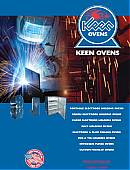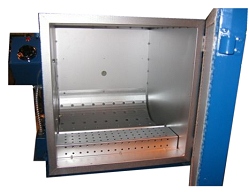Industrial Ovens
Front-Loading
![]() Under 10 cubic feet
Under 10 cubic feet
![]() 10-20 cubic feet
10-20 cubic feet
![]() Over 20 cubic feet
Over 20 cubic feet
![]() See All
See All
Top-Loading
![]() Under 10 cubic feet
Under 10 cubic feet
![]() 10-20 cubic feet
10-20 cubic feet
![]() Over 20 cubic feet
Over 20 cubic feet
![]() See All
See All
Learn About Our Industrial Ovens
Welding Ovens
![]() CONEX Storage
CONEX Storage
![]() Stick Electrodes
Stick Electrodes
![]() Sub-Arc Flux
Sub-Arc Flux
![]() Wire Spools
Wire Spools
![]() Tig Filler Wire
Tig Filler Wire
![]() Multi-Purpose
Multi-Purpose
![]() Nitrogen Purge
Nitrogen Purge
![]() See All
See All
 Order Our Free Catalog Today Click Here |
| Available Inventory |
Electrode Storage
One day some guy in a hurry grabs a rod that's been left out and is covered with rust. Next thing he knows, it is welding better than a brand new clean one. After experimenting with various coatings of silica, cellulose, sodium and other elements it was found that putting a flux coating on the filler rod produced a very sound weld. Click here to view our Electrode Rod Storage Ovens! Flux burns and turns into a shielding gas that protects the weld pool from atmospheric contaminants such as hydrogen, nitrogen, oxygen and others. These contaminants get into the weld pool and cause defects such as cracking, and porosity (worm holes.) These defects create a weak point where the weld can fail under stress or load. To keep that from happening, rods should always be stored properly. What happens, especially in low-hydrogen rods, is moisture gets into the flux. Low-hydrogen rods are just what their name states…low hydrogen. They need to be kept dry or porosity will be introduced into the weld bead. This will happen at the beginning of the bead with each new rod used, and diminish as the rod heats up and burns the moisture out as it is being consumed. Many job sites and shops do not use proper electrode storagae and moisture gets into the flux. This moisture turns into steam and leaves small bubbles in the weld pool which leaves holes. Rods need to be stored in hermetically sealed boxes in a vacuum. Once the box is open, humidity in the air will enter the rod flux, so something must be done to keep this from happening. Too many people use methods they have heard from other welders which do not work. It's almost like old wives' tales, the stories out there. Improper Electrode Rod StorageSome say proper rod storage is wrapping the rods in plastic and putting them in the freezer. Others say get an old refrigerator and put a light bulb in it. The only correct method of storing rods properly is to put them in an approved rod oven. An approved rod oven will keep the rods at their manufacturer-rated storage temperature, and can be used to re-bake the rods after they have been exposed to atmospheric moisture. Although E-XX10, 11, 12, & 13 rods can be stored in dry boxes at room temperature, most other rods are recommended to be stored at anywhere from 150 to 400 degrees Fahrenheit. That's why the refrigerator with a light bulb is not good for electrode storage. It will not achieve 400 degrees, and the light bulb is not going to create uniform heat throughout the inside. The heat needs to be consistent and that is achieved with a professional oven whether portable, floor or bench. |
 In stick welding we use a rod (welding electrode rod)
covered with flux. It was discovered in WWII that coatings on the filler rod made
it weld better. On ships and other production sites, bare metal rods were used
usually in the flat position. Rods were stored out in the open and not much care
was taken with them.
In stick welding we use a rod (welding electrode rod)
covered with flux. It was discovered in WWII that coatings on the filler rod made
it weld better. On ships and other production sites, bare metal rods were used
usually in the flat position. Rods were stored out in the open and not much care
was taken with them.